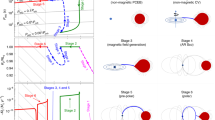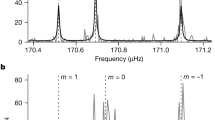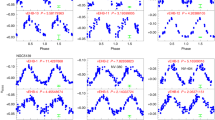Abstract
Some main-sequence stars of spectral type A are observed to have a strong (0.03–3 tesla), static, large-scale magnetic field, of a chiefly dipolar shape: they are known as ‘Ap stars’1,2,3,4, such as Alioth, the fifth star in the Big Dipper. Following the discovery of these fields, it was proposed that they are remnants of the star's formation, a ‘fossil’ field5,6. An alternative suggestion is that they could be generated by a dynamo process in the star's convective core7. The dynamo hypothesis, however, has difficulty explaining high field strengths and the observed lack of a correlation with rotation. The weakness of the fossil-field theory has been the absence of field configurations stable enough to survive in a star over its lifetime. Here we report numerical simulations that show that stable magnetic field configurations, with properties agreeing with those observed, can develop through evolution from arbitrary, unstable initial fields. The results are applicable equally to Ap stars, magnetic white dwarfs and some highly magnetized neutron stars known as magnetars. This establishes fossil fields as the natural, unifying explanation for the magnetism of all these stars.
This is a preview of subscription content, access via your institution
Access options
Subscribe to this journal
Receive 51 print issues and online access
$199.00 per year
only $3.90 per issue
Buy this article
- Purchase on Springer Link
- Instant access to full article PDF
Prices may be subject to local taxes which are calculated during checkout

Similar content being viewed by others
References
Babcock, H. W. Zeeman effect in stellar spectra. Astrophys. J. 105, 105–119 (1947)
Landstreet, J. D. & Mathys, G. Magnetic models of slowly rotating magnetic Ap stars: aligned magnetic and rotation axes. Astron. Astrophys. 359, 213–226 (2000)
Bagnulo, S. et al. A study of polarized spectra of magnetic CP stars: predicted vs. observed Stokes IQUV profiles for β CrB and 53 Cam. Astron. Astrophys. 369, 889–907 (2001)
Kochukhov, O. et al. Magnetic Doppler imaging of 53 Camelopardalis in all four Stokes parameters. Astron. Astrophys. 414, 613–632 (2004)
Cowling, T. G. On the Sun's general magnetic field. Mon. Not. R. Astron. Soc. 105, 166–174 (1945)
Moss, D. On the magnetic flux distribution in magnetic CP stars. Mon. Not. R. Astron. Soc. 226, 297–307 (1987)
Charbonneau, P. & MacGregor, K. B. Magnetic fields in massive stars. I. Dynamo models. Astrophys. J. 559, 1094–1107 (2001)
Prendergast, K. H. The equilibrium of a self-gravitating incompressible fluid sphere with a magnetic field. I. Astrophys. J. 123, 498–507 (1956)
Borra, E. F., Landstreet, J. D. & Mestel, L. Magnetic stars. Annu. Rev. Astron. Astrophys. 20, 191–220 (1982)
Wright, G. A. E. Pinch instabilities in magnetic stars. Mon. Not. R. Astron. Soc. 162, 339–358 (1973)
Tayler, R. J. The adiabatic stability of stars containing magnetic fields—I. Toroidal fields. Mon. Not. R. Astron. Soc. 161, 365–380 (1973)
Nordlund, Å. & Galsgaard, K. A 3D MHD code for parallel computers. 〈http://www.astro.ku.dk/~aake/papers/95.ps.gz〉 (1995).
Kamchatnov, A. M. Topological solitons in magnetohydrodynamics. Zh. Eksp. Teor. Fiz. 82, 117–124 (1982)
Markey, P. & Tayler, R. J. The adiabatic stability of stars containing magnetic fields—II. Poloidal fields. Mon. Not. R. Astron. Soc. 163, 77–91 (1973)
Markey, P. & Tayler, R. J. The adiabatic stability of stars containing magnetic fields—III. Additional results for poloidal fields. Mon. Not. R. Astron. Soc. 168, 505–514 (1974)
Flowers, E. & Ruderman, M. A. Evolution of pulsar magnetic fields. Astrophys. J. 215, 302–310 (1977)
Hubrig, S., North, P. & Mathys, G. Magnetic AP stars in the Hertzsprung-Russell diagram. Astrophys. J. 539, 352–363 (2000)
Zhang, M. & Low, B. C. Magnetic flux emergence into the solar corona. III. The role of magnetic helicity conservation. Astrophys. J. 584, 479–496 (2003)
Hsu, S. & Bellan, P. A laboratory plasma experiment for studying magnetic dynamics of accretion discs and jets. Mon. Not. R. Astron. Soc. 334, 257–261 (2002)
Chui, A. Y. K. & Moffatt, H. K. The energy and helicity of knotted magnetic flux tubes. Proc. R. Soc. Lond. A 451, 609–629 (1995)
Putney, A. in Eleventh European Workshop on White Dwarfs (eds Solheim, J. E. & Meistas, E. G.) 195–205 (ASP Conf. Ser. 169, Astronomical Society of the Pacific, San Francisco, 1999)
Wickramasinghe, D. T. & Ferrario, L. Magnetism in isolated and binary white dwarfs. Publ. Astron. Soc. Pacif. 112, 873–924 (2000)
Mereghetti, S. & Stella, L. The very low mass X-ray binary pulsars: A new class of sources? Astrophys. J. 442, 17–20 (1995)
Mazets, E. P. et al. Activity of the soft gamma repeater SGR 1900 + 14 in 1998 from Konus-Wind observations: 2. The giant August 27 outburst. Astron. Lett. 25, 635–648 (1999)
Duncan, R. C. & Thompson, C. Formation of very strongly magnetized neutron stars—Implications for gamma-ray bursts. Astrophys. J. 392, 9–13 (1992)
Thompson, C. & Duncan, R. C. The soft gamma repeaters as very strongly magnetized neutron stars—I. Radiative mechanism for outbursts. Mon. Not. R. Astron. Soc. 275, 255–300 (1995)
Author information
Authors and Affiliations
Corresponding author
Ethics declarations
Competing interests
The authors declare that they have no competing financial interests.
Rights and permissions
About this article
Cite this article
Braithwaite, J., Spruit, H. A fossil origin for the magnetic field in A stars and white dwarfs. Nature 431, 819–821 (2004). https://doi.org/10.1038/nature02934
Received:
Accepted:
Issue Date:
DOI: https://doi.org/10.1038/nature02934
This article is cited by
-
Dynamics of the Tachocline
Space Science Reviews (2023)
-
Stellar mergers as the origin of the blue main-sequence band in young star clusters
Nature Astronomy (2022)
-
Macroscale fast flow and magnetic-field generation in two-temperature relativistic electron–ion plasmas of astrophysical objects
Astrophysics and Space Science (2022)
-
Ultraviolet spectropolarimetric diagnostics of hot star magnetospheres
Astrophysics and Space Science (2022)
-
Constraints on relic magnetic black holes
Journal of High Energy Physics (2022)
Comments
By submitting a comment you agree to abide by our Terms and Community Guidelines. If you find something abusive or that does not comply with our terms or guidelines please flag it as inappropriate.



